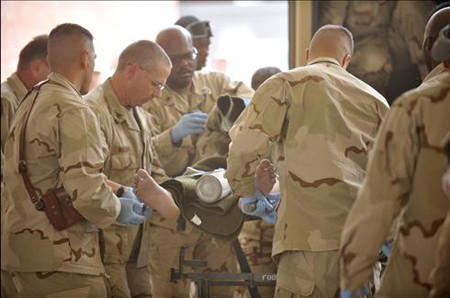USA Today, October 28, 2010
Despite advances, troops face long recovery after head trauma
He says each nearly died after a homemade bomb, also known as an improvised explosive device or IED, exploded
By Gregg Zoroya
KANDAHAR AIR BASE, Afghanistan — Army Spc. Daus Hempker, 22, sits listlessly on the edge of a hospital bed, still shaken and ashen-faced three days after a buried explosive detonated a few feet away from him during a foot patrol.

A U.S. serviceman injured in an IED blast is transported from a medevac helicopter flight to the trauma bay at a medical treatment facility in Kandahar, Afghanistan, on Sept. 18. (Photo: Jack Gruber/ USA TODAY)
"It disintegrated a guy," Hempker says, his voice barely above a whisper. "The next thing I remember was waking up and ... all I could hear was screaming."
He looks physically unharmed. But the symptoms Hempker describes — a momentary loss of consciousness when the bomb went off, vomiting, blurred vision, dizziness, sensitivity to light and monster headaches — are evidence of a concussion or mild traumatic brain injury, says Navy Capt. Michael Wagner, a neurologist at the NATO hospital.
Hempker is among hundreds of U.S. troops being identified as concussion victims each month under new, more aggressive medical treatment guidelines instituted by the Pentagon in July. Those rules require that any servicemember caught within roughly 50 yards of a blast be pulled from the battlefield for at least 24 hours and examined for evidence of concussion. The same goes for troops in a vehicle or building struck by a bomb.
In some cases, an entire squad can be pulled back to a forward base camp until each soldier is examined by a medic. In cases where symptoms persist, as happened with Hempker, the servicemember must remain out of combat, and allowed rest and medication until symptoms go away.
Medics and corpsmen are pushing hard to enforce the rules, soldiers say.
"I tried not getting on the helicopter," says Army Sgt. Jonathan Avery, 25, stunned by a blast on Sept. 17 while on foot patrol west of Kandahar. "My medic pretty much yelled at me, and they dragged me away to the helicopter, saying it's pretty serious."
'It's a shock'
At the NATO hospital, Wagner sees about 70 of these patients a month — Marines fighting in nearby Helmand province, soldiers from the 101st Airborne pushing into Taliban strongholds in Kandahar province. He says each nearly died after a homemade bomb, also known as an improvised explosive device or IED, exploded.
"This country is loaded with IEDs," Wagner says. "No matter how you've prepared (these troops), no matter how much you tell them this is coming, it's a shock."
He sees them one at a time, carefully taking a history of what they know. Each seems uncertain about exactly what happened. There was the flash, dirt, debris and an overwhelming force that pushed each of them off their feet or up into the air, they say. They know friends who were a few feet closer to the explosion died.
"Do you remember the blast?" Wagner asks Army Spc. Joshua Morales, 20. He was on the same patrol as Hempker. An Afghan soldier walking between them stepped on a hidden pressure plate and was killed.
Morales searches for words. "I remember the feeling of the blast, and I remember just coming back to whatever it was," he says, "and there was just dust everywhere."
They suffer from headaches so severe, some say, they want to pull their eyes out.
"It is like somebody was in the back of your head poking you with knife, trying to get as deep in as they could," says Navy Corpsman Brent McGuire, 23, who was twice knocked down by roadside bombs in Helmand province.
Their thinking is cloudy. They struggle with simple tests, such as reciting the months in reverse. Sounds are muffled — like being under water. Heavy sunglasses shield eyes that cannot tolerate bright light.
Recurring nightmares
Some say their hearts race for days afterward.
Even along the boardwalks of fortified bases, they instinctively search for signs of buried explosives.
"I know this is safe ground, (but) I still do it," says Army Pfc. Tyrell Loper, 22.
He was thrown into the air by a buried explosive that detonated west of Kandahar during a patrol Sept. 17. Two Americans next to him were killed — 1st Lt. Eric Yates, 26, and Staff Sgt. Jaime Newman, 27.
There are flashbacks and nightmares.
"(The IED) is coming. But I can't move," says Army Pfc. Charles Tice, 20, of his recurring dreams. He was thrown half-way out of the turret of an armored vehicle that ran over an IED Sept. 17.
Mostly, they know that after the symptoms go away, they will return to war and there will be more hidden explosives.
"I just don't want it to happen again," Morales says of the blast.
"I'm worried about something psychologically getting damaged inside me even more than it already is," Morales says. "I'm only 20 years old. I feel like I'm frigging 40."
Characters Count: 5796
